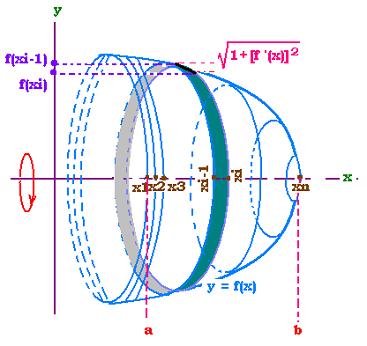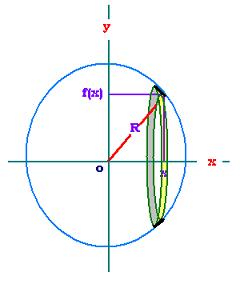Calculus II
Contents
Series
Integrals
Definite integrals
Some primitives
Numerical methods
Exercices
© The scientific sentence. 2010
|
|
Calculus II: Volume of solid of revolution
We have seen that the length of an arc describes by a
function f(x) is:
dL = [1 + (f '(x))2] 1/2 dx
We use this result to determine the lateral area (curved surface) generated
by the revolution of a curve around an axis.
1.Lateral area generated by a curve

Let f(x) a function continuous on the interval [a, b],
and f '(x) its continuous derivative on ]a, b[.
We want to determine the area generated, between
x = a and x = b, by the revolution of the curve of f(x)
around the x-axis.
Let divide the interval [a, b] in n equal sub-intervals
of width Δx2, Δx2, ..., Δxi-1, Δxi, ..., Δxn.
For each point x = xi corresponds its image
f(xi) and the elementary arc length ΔLi = [1 + (Δf(xi)/Δxi)2]1/2, where
Δf(xi) = f(xi) - f(xi-1), and
Δxi = xi - xi-1.
By a revolution around the x-axis the elementary arc
length ΔLi generates an elementary
lateral area :
ΔAi = ΔLi . 2π f(xi)
The total area A is the sum of the contributions
of all the elementary Ai; so
| | |
i = n
| |
| A = lim | Σ | |
Ai
|
| n →+∞ | |
i = 1
| |
=
| | |
i = n
| |
| 2π lim | Σ | |
f(xi) [1 + (Δf(xi)/Δxi)2] 1/2
|
| n →+∞ | |
i = 1
| |
=
| |
x = b
| |
| 2π ∫ | |
f(x) [1 + (f '(x))2] 1/2 dx
|
| |
x = a
| |
2.Example

Lateral area of a sphere of radius R centered on the
origin.
We determine first the lateral area of a half-sphere
generated by the curve of:
f(x) = [R2 - x2]1/2.
around the x-axis between 0 and R.
The function is continuous on [-R, R] then on
[0, R]. Its derivative f '(x) is continuous on ]0, R[
f '(x) = - x/[R2 - x2]1/2
dL = [1 + (f '(x))2]1/2 dx =
= R/[R2 - x2]1/2 dx
Therefore
| |
x = R
| |
| A = 2π ∫ | |
[R2 - x2] 1/2
R/[R2 - x2] 1/2 dx
|
| |
x = 0
| |
=
= 2π R2
Hence
The lateral area of a sphere of radius R
is 2 x A = 4π R2
5. Exercises
|
|